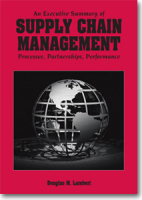Ohio State University Fisher College of Business Supply Chain Management
An Executive Summary of SUPPLY CHAIN MANAGEMENT Processes, Partnerships, Performance.
An Executive Summary of SUPPLY CHAIN MANAGEMENT Processes, Partnerships, Performance
One of the most significant paradigm shifts of modern business management is that individual businesses no longer compete as solely autonomous entities, but rather within supply chains.
In this emerging competitive environment, the ultimate success of the business will depend on management’s ability to integrate the company’s intricate network of business relationships.
The members of The Global Supply Chain Forum refer to the management of this network of relationships as supply chain management. Successful supply chain management requires cross-functional integration within the firm and across the network of firms that comprise the supply chain. It is focused on relationship management and the improvements in performance that result from better management of key relationships.
However, in many companies executives struggle to achieve the necessary integration. By understanding the supply chain management processes and how they should be implemented, executives will be able to create more integrated supply chains which will lead to higher revenues and increased profitability for all member firms.
In this executive summary, the eight processes that need to be managed and integrated for successful supply chain management are identified and described.
Then, achieving cross-functional and cross-firm involvement using the supply chain management processes is addressed. Next, the essential linkages required to facilitate the integration of supply chain members, the customer relationship management (CRM) and supplier relationship management (SRM) processes, are explained.
The remaining six processes are coordinated through the CRM and SRM linkages. Each process should be evaluated based on its contribution to overall financial performance and a method for measuring this contribution is presented. Next, there is a description of the partnership model, which can be used to structure relationships with key members of the supply chain.
Finally, there is a summary of the supply chain management framework and conclusions.
What’s Related


Favorites





